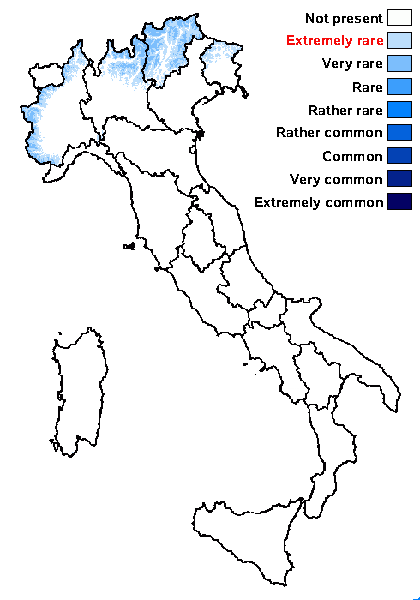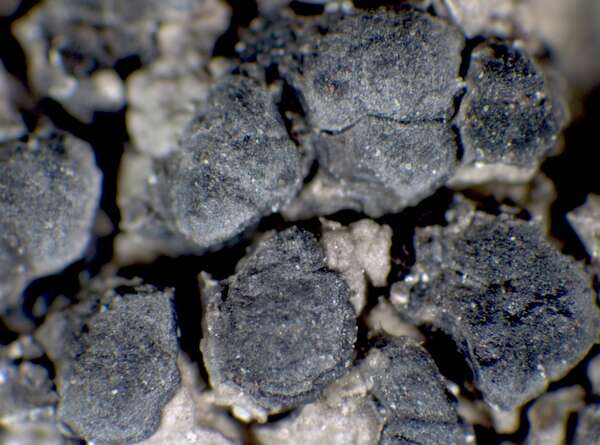Ropalospora lugubris (Sommerf.) Poelt
in Hertel, Sched. ad Lecid. Exs., fasc. 2: nr. 40, 1980. Basionym: Lecidea lugubris Sommerf. - Flor. Lappon.: 143, 1826.
Synonyms: Bacidia lugubris (Sommerf.) Zahlbr.; Bilimbia lugubris (Sommerf.) Th. Fr.; Fuscidea lugubris (Sommerf.) P. James & Purvis; Lecidea caudata Nyl.; Ropalospora cafra A. Massal.; Toninia caudata (Nyl.) Arnold; Toninia lugubris (Sommerf.) Th. Fr.
Distribution: N - Frl (TSB 1666), TAA, Lomb, Piem (Isocrono & al. 2004).
Description: Thallus crustose, episubstratic, rimose-areolate, brownish-grey, ash-grey or dark grey-brown, forming irregular, up to 10 cm wide patches, often delimited by a dark prothallus. Areoles angular, 0.2-0.5 mm wide, flat to usually convex, contiguous or dispersed over a black prothallus, most often esorediate, but sometimes with brown (cream when eroded), orbicular, to 3 mm wide soralia. Medulla white, I-. Apothecia lecideine, brown-black to black, constricted at base, 0.4-0.8(-1.2) mm across, with a flat to convex, sometimes faintly grey-pruinose disc, and a glossy, persistent, mostly raised and flexuous proper margin. Proper exciple 60-100(-160) μm wide laterally, dark brown-black in outer part, progressively paler inward, the pigmented parts K+ intensifying brown, of narrow, evenly thickened hyphae with at least some lumina >3 times as long as wide; epithecium dark olive-brown; hymenium colourless, 55-80(-100) μm high, I+ blue; paraphyses lax, mostly simple, 1.5(-2) μm thick a mid-level, the apical cells 3-6 μm wide; hypothecium pale reddish brown in upper part, darker brown in lower part, 100-180 μm high, inspersed with oil droplets. Asci 8-spored, clavate, the tholus with an inner amyloid zone, an outer amyloid zone and a less amyloid zone inbetween, surrounded by a slightly amyloid gelatinous matrix. Ascospores 6-9(-11)-septate, hyaline, acicular-clavate, with one attenuate end, 29-58 x 4-7 μm. Pycnidia immersed to sessile, dark brown-black, usually in clusters. Conidia bacilliform 3.5-6 x c. 1 μm. Spot tests: thallus K-, C-, KC-, P-. Chemistry: unidentified substances. Note: an arctic-alpine to boreal-montane, perhaps circumpolar lichen found on steeply inclined surfaces of hard siliceous rocks in cold-humid upland areas.
Growth form: Crustose
Substrata: rocks
Photobiont: green algae other than Trentepohlia
Reproductive strategy: mainly sexual
Commonnes-rarity: (info)
Alpine belt: very rare
Subalpine belt: extremely rare
Oromediterranean belt: absent
Montane belt: extremely rare
Submediterranean belt: absent
Padanian area: absent
Humid submediterranean belt: absent
Humid mediterranean belt: absent
Dry mediterranean belt: absent

Predictive model
Growth form: Crustose
Substrata: rocks
Photobiont: green algae other than Trentepohlia
Reproductive strategy: mainly sexual
Commonnes-rarity: (info)
Alpine belt: very rare
Subalpine belt: extremely rare
Oromediterranean belt: absent
Montane belt: extremely rare
Submediterranean belt: absent
Padanian area: absent
Humid submediterranean belt: absent
Humid mediterranean belt: absent
Dry mediterranean belt: absent

Predictive model
 Index Fungorum
Index Fungorum
 GBIF
GBIF




